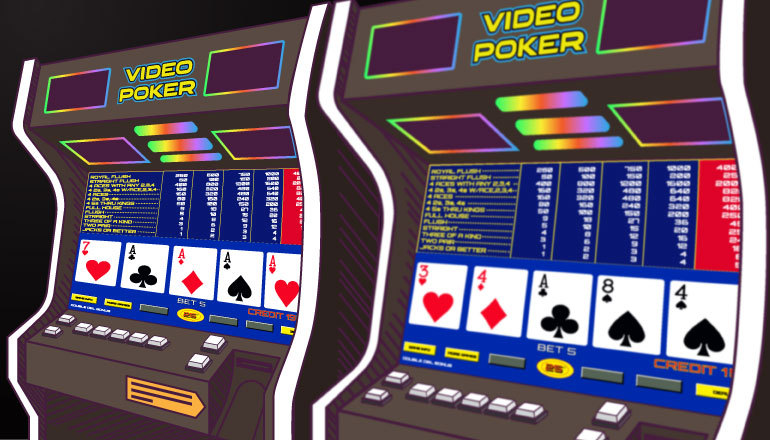If you’re curious about how cards are dealt in video poker, you’ve come to the right place! Video poker is a thrilling casino game that combines the excitement of poker with the convenience of a slot machine. So, let’s dive in and explore the fascinating world of card dealing in video poker.
When it comes to video poker, the first thing to understand is that the game uses a standard 52-card deck, just like traditional poker. However, unlike live poker, you’re not competing against other players. Instead, you’re aiming to build the best possible hand to win against the computer.
In video poker, the cards are dealt to you by a random number generator (RNG) software. This ensures that every card drawn is completely random, providing a fair and impartial gameplay experience. So, whether you’re a beginner or an experienced player, let’s uncover the secrets behind how video poker cards are dealt!
Now that we know the basics, let’s delve deeper into the mechanics of card dealing in video poker. Whether you’re dreaming of hitting that royal flush or aiming for a simple pair, understanding how cards are dealt is the first step to mastering this exhilarating game. So, let’s explore the ins and outs of video poker card dealing together!
In video poker, cards are dealt using a random number generator (RNG) algorithm, ensuring fairness. The process involves the following steps:
- Shuffling: The deck of cards is shuffled to ensure randomness.
- Betting: Players place their bets.
- Dealing: The RNG selects five cards for the player.
- Drawing: Players can choose which cards to keep or discard.
- Reveal: The discarded cards are replaced, and the final hand is revealed, determining wins and losses.

How Are Cards Dealt in Video Poker?
Welcome to this comprehensive guide on how cards are dealt in video poker. In this article, we will explore the intricacies of how the cards are distributed in this popular casino game. Whether you’re a novice player looking to learn the basics or an experienced gambler seeking a deeper understanding, this article will provide you with all the information you need to know. So, let’s dive in and discover the inner workings of card distribution in video poker.
The Mechanics of Card Dealing
Before we delve into the specifics of card dealing in video poker, it’s essential to understand the general mechanics of the game. Video poker is a digital version of traditional poker, where players aim to create the best possible hand by selecting and discarding cards from a virtual deck. The game begins once the player places a bet and presses the “Deal” button. From this point onwards, the computer program algorithm takes over, simulating the shuffling and dealing of the cards.
Each hand in video poker is typically dealt from a standard 52-card deck, with the same probabilities and odds as a traditional game. However, the cards are not physically shuffled and dealt by a human dealer but instead produced through a random number generator (RNG) in the software. The RNG ensures that each dealt card is entirely independent and unbiased, replicating the randomness of a physical deck of cards. This ensures fair gameplay and eliminates any possibilities of cheating or manipulation.
Step 1: Placing Your Bet
Before the cards are dealt, players must first place their bets. In video poker, bets are typically made by selecting the desired denomination and number of credits to wager. These options can vary depending on the specific video poker variant being played. Once the player has chosen their bet amount, they can proceed to the next step, which is initiating the card dealing process.
Some video poker games may also require players to choose the number of hands they wish to play simultaneously. This feature, commonly known as “multi-hand,” allows players to have multiple hands dealt at once, increasing the excitement and potential winnings. However, for the purpose of this article, we will mainly focus on the standard single-hand video poker.
Step 2: Initiating the Dealing Process
After placing the bet, the player can initiate the card dealing process by pressing the “Deal” button. Once pressed, the random number generator algorithm immediately generates five cards from the virtual deck. These five cards are then displayed on the screen for the player to evaluate and strategize their next moves. It’s important to note that the cards displayed are purely for visual representation, and the actual cards dealt have already been determined in the background by the RNG.
The five cards dealt initially in video poker are known as the player’s “first hand.” From this point forward, the player has the freedom to choose which cards to keep and which cards to discard. The objective is to create the highest-ranking hand possible, based on the predetermined paytable of the specific video poker variant being played. Once the player has made their card selection, they can proceed to the final step.
Understanding Card Selection and Discard
Now that we’ve covered the basics of how the cards are dealt in video poker, let’s delve deeper into the process of card selection and discard. After the initial five-card deal, the player can choose to keep all, some, or none of the cards they were dealt. The objective is to strategically select the cards that have the highest probability of creating a winning hand. To assist players in making informed decisions, the game software often highlights the cards with the best strategic value.
The Importance of the Hold Button
In video poker, the “Hold” button plays a crucial role in the card selection process. Once the player decides which cards to keep, they can individually press the “Hold” button beneath each desired card. By doing so, the software recognizes these cards as being “on hold” and ensures that they will not be replaced during the subsequent draw. This function allows players to fine-tune their hand, aiming for a specific winning combination.
Optimal Strategy and Probability
Mastering the art of card discarding and selection in video poker is essential for optimizing your chances of winning. While each variant of video poker has its own optimal strategies, there are some general guidelines to keep in mind. One fundamental principle is to always aim for the highest-ranking hand on the paytable, as this ensures the most favorable odds and payouts. Additionally, it’s crucial to understand the probability of drawing specific cards based on the initial deal and adjust your strategy accordingly.
Taking Your Game to the Next Level
Now that you have a thorough understanding of how cards are dealt in video poker, you can level up your gameplay and enhance your chances of success. By studying and implementing optimal strategies and probability calculations, you can become a formidable player and potentially secure impressive winnings. Remember, practice makes perfect, so don’t be discouraged if you don’t see immediate results. With time and dedication, you’ll become a skilled video poker player.
Key Takeaways: How Are Cards Dealt in Video Poker?
- Video poker uses a standard deck of 52 cards.
- The cards are shuffled randomly by a computer program.
- After placing a bet, you are dealt five cards face-up on the screen.
- You can choose to keep or discard any of the initial five cards.
- Replacement cards are then dealt to replace the discarded cards.
Frequently Asked Questions
Welcome to our FAQ section on how cards are dealt in video poker! If you’re curious about the mechanics of card distribution in this popular casino game, you’ve come to the right place. Read on to find answers to some common questions players ask about card dealing in video poker.
1. Are the cards in video poker dealt randomly?
Yes, in video poker, the cards are always dealt randomly using a software algorithm known as a random number generator (RNG). This ensures fairness and eliminates any patterns or biases in the card distribution. Every card in the deck has an equal chance of being dealt on every hand, just like in a physical deck of cards.
The RNG generates a sequence of numbers that correspond to specific cards, and these numbers determine which cards are dealt to the player’s hand. The process is continuously running in the background, creating a new set of random numbers for each hand played, ensuring a fair and unpredictable card distribution.
2. Can the casino manipulate the card dealing in video poker?
No, reputable online casinos cannot manipulate the card dealing in video poker. The use of RNGs and strict regulations in the gambling industry prevent any manipulation of card distribution. Online casinos undergo regular audits and testing to ensure that their games are fair and the RNGs are functioning properly.
The algorithms behind the RNG are designed to provide truly random results. They go through rigorous testing and certification to ensure their integrity. Additionally, regulatory bodies such as eCOGRA and independent auditors monitor the casinos to verify the fairness of the card dealing and overall gameplay.
3. How many cards are dealt in video poker?
In most video poker variations, five cards are initially dealt to the player. These cards make up the player’s starting hand. The player then has the option to hold or discard any number of cards to improve their hand. The discarded cards are replaced by new cards to complete the final hand, which decides the outcome of the game.
However, it’s important to note that there are different video poker variations, such as Jacks or Better, Deuces Wild, and Joker Poker, each with its own unique rules and card dealing procedures. While five-card hands are the most common, some variations may have different card dealing rules.
4. Can I influence the outcome of the card dealing in video poker?
No, you cannot influence the outcome of the card dealing in video poker. Video poker is a game of chance, and the card distribution is determined by the random number generator (RNG). The cards you receive are independent of any actions or decisions you make.
However, your choices and strategy after receiving your initial hand can impact your overall gameplay and chances of winning. Knowing the correct strategies to hold or discard cards can increase your chances of forming winning combinations, but it does not affect the randomness of the card dealing itself.
5. How are the replacement cards determined in video poker?
The replacement cards in video poker are also determined by the random number generator (RNG). When a player chooses to discard certain cards from their initial hand, the RNG generates new numbers to represent the replacement cards. These new numbers correspond to the remaining cards in the virtual deck.
The replacement cards are then dealt to the player, completing their final hand. Again, this happens randomly, ensuring fairness and unpredictability. The RNG ensures that each replacement card is as likely to be any card in the deck, just like in a physical deck of cards.
Video Poker – How to Win and How it Works • The Jackpot Gents
Summary
So, let’s sum it up. In video poker, cards are dealt randomly by a computer program called a random number generator. The goal is to make the best possible hand using the cards you receive. Each hand is replaced by new cards after you choose which ones to keep. It’s important to understand the rules and strategy to improve your chances of winning.









